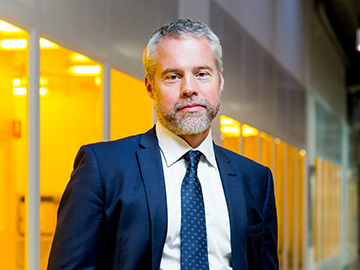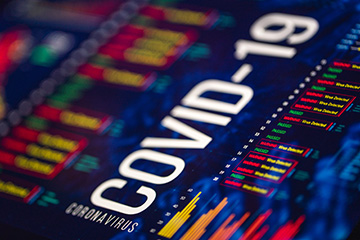
Benjamin Eggleton [Credit: University of Sydney]
Whether they’re used for virus detection, improved screening, health monitoring or to measure transmissibility, advances in sensor technology could be game changing as we move into the next phase of the COVID-19 pandemic. Considering the versatility of sensors, however, the questions becomes: where do researchers focus their efforts?
OPN spoke with OSA Fellow Benjamin Eggleton—director of Sydney Nano, the University of Sydney, Australia, and co-chair of a workshop on setting research priorities for sensor technology—about efforts at the University of Sydney to nail down where sensors could have the greatest impact on COVID-19, and on infectious disease in general. Eggleton and the workshop participants published a letter in Nature Biotechnology detailing the outcomes of the study and the multi-stakeholder approach the group used to arrive at its conclusions.
What is your personal perspective on how sensor technology has been used during COVID-19?
I’m co-director of the New South Wales Smart Sensor network. That’s very much a consortium of universities, funded by the NSW state government, whose mission is to translate sensor technology to address unmet needs in a number of different sectors—including medtech and COVID-19. In this role, I am thinking always about end-users and industry. But my main job is director of Sydney Nano, the University of Sydney’s flagship, multidisciplinary institute where I am responsible for promoting transformational opportunities enabled by multidisciplinary collaboration anchored in nanotechnology. It was in this framework, within which we have a sensor diagnostics cluster, that I started a strategy on nanohealth and nanomedicine.
I pushed that group to look early on in 2020 at opportunities for advancing sensor capabilities for COVID-19 because it was becoming clear to me that there was an obsession for virus and antibody detectors. These parallel streams were really starting to emerge, and there was this big push for bringing the virus detectors into mainstream because at the onset they were experimental.
What emerged from those conversations [within the sensor diagnostics cluster] was a couple of other very interesting areas where sensors were going to play a key role—in particular, remote sensing and wearables. We quickly realized that it’s much more complicated and nuanced than just detecting the virus or antibodies. It’s actually about protecting people and protecting high-risk sites like hospitals.
How might sensors be used in the future—for COVID-19 or for other diseases?
That’s what we were trying to assess and determine with this project, because there are so many possibilities.
We quickly realized that it’s much more complicated and nuanced than just detecting the virus or antibodies. It’s actually about protecting people.
—Benjamin Eggleton
We tried to break sensors down into a couple of different categories for the purposes of this project. On the one hand, there are sensors that detect the virus and antibodies, looking for genetic biomarkers—we’re pretty familiar with that narrative. But there’s this whole narrative around physiological signatures of infection and remote sensing, such as the temperature of the skin. Of course, that’s so primitive and it doesn’t really work that well, but if you actually, for example, detect the change in the temperature when someone walks from outdoors to indoors, that’s a much better measure of whether they’re infected.
The Holy Grail is a COVID breathalyzer, and that’s on the horizon, and then there’s a lot of interesting work on skin biosensors and wearables. The reality is that even now in Australia, it’s a pain to go get tested. And you’re not really sure when you need to get tested—the message is inconsistent. Can we instead look for signatures of infection using wearable technologies and sensors attached to the skin, like a Fitbit, that inform someone that they need to get tested? For example, can we use sensors to detect how people snore at night?
Very quickly, you realize you’re overwhelmed with possibilities.
So the inspiration for this workshop was to narrow down the field of possibilities?
As director of Sydney Nano, my role is to guide the institution toward opportunities for impact, and there were just too many different directions to go in. Every time we talked to a pathologist, or a clinician, or someone in public health, we’d be told a different perspective. We needed to prioritize, and we needed to align our research, especially with the end-user stakeholder perspective.
So what we did, which I think was very exciting, was to use a process of co-design—a contemporary approach to prioritizing research that brings together innovators, end users, manufacturers and all sorts of different stakeholders to have a structured conversation. We reached out to Allison Tong, who’s a professor here at the Sydney School of Public Health and a scholar on co-design in chronic disease and also Tania Sorrell who is the director of the Marie Bashir Institute for Infectious Diseases and Biosecurity at the University of Sydney.
With Allison taking the lead on the co-design process, Tania as our credentialed expert on infectious disease, and Sydney Nano’s multidisciplinary capability in nanohealth and smart sensors, we were in a strong position to have a unique conversation about COVID-19 and smart sensors. We ran a process that eventually brought into a virtual room about 80 people, including people who had been infected, clinicians, doctors, public health care professionals, innovators, engineers and scientists.
It was through that very powerful process that we’ve been able to prioritize and put some light on some really interesting perspectives on what is important going forward, and where you might invest in sensor technology to bring solutions that really matter and make a difference in the real world.
That must have created an interesting optimization problem. How did you address that?

[Credit: Getty Images]
This is what Allison is good at, and there is rigor and a process behind it. You don’t go into that [virtual] room of stakeholders without already having done a lot of homework. And we know that the outcomes of that process are quite unique to the Australian setting—what we inform from this particular study might not be reproduced in a North-American setting where you’re still in the midst of the pandemic and the priorities are different, but I am sure the findings are still very interesting.
What you’re essentially doing is through initial ranking, based on surveys, establishing the meta thematic areas that you would like to tease out in that workshop, which then breaks out into specific breakout sessions where you have assembled a diverse group of stakeholders to have a structured discussion. Then we tried to pick out the themes from that structured discussion. What are the things that align and resonate? From that, you can use statistics to build up priorities.
What’s interesting from this project is it actually spins off a whole bunch of other interesting possibilities, related to COVID-19 and also more general to infectious disease and even beyond. We’ve got to look at some of the recommendations from this report because these issues don’t go away immediately with a vaccine. There’s going to be this gray area for a couple of years where we’re going to be putting out fires all over the place. For example, one of the really significant recommendations was sensing the transmissibility of the disease, or how infectious you are. How do you sense that?
Sensors are going to play a powerful role, and there’s photonics running through all of these sensor technologies. There’s photonics in biosensors, plasmonic enhanced sensors, imaging, wearables, breath analyzers, 2D materials based on optics, contactless sensors—it’s all photonics.
What are some other significant outcomes that came out of this project?
There are all sorts of interesting ideas that are being put forward. Some of these ideas are not new, but they should be deemed as investment priorities according to this particular conversation for this particular community.
The first recommendation, a point-of-care screening test for COVID-19, is a no brainer. Example ideas under this recommendation include targeting a different type of organ other than blood; detecting other compounds of chemicals that the body generates due to infection that may be used as a signature of disease; developing wearable noninvasive devices for health care workers to capture clinical parameters and then using AI to analyze the data; and using a microphone to detect characteristics of breathing.
There’s so much information here to inform clinicians in the community about what is important. It’s the beginning of the conversation, not the end of the conversation.
—Benjamin Eggleton
Two other major recommendations are detecting how infectious a person is—perhaps by developing face masks with sensors or using sensors to measure cough information—and identifying the level of immunity a person has to COVID-19 or its change over time. [Editor’s note: Table 1 of the group’s letter in Nature Biotechnology gives a more detailed look at the group’s recommendations.]
I think there’s so much information here to inform clinicians in the community about what is important. It’s the beginning of the conversation, not the end of the conversation. Certainly, for the University of Sydney, I think this is going to really put a light on where we will invest and strategize and make priorities in the next phase.
And many of these are also broader than just COVID-19. You could look at all viruses, including other infectious diseases, and many of these priorities map onto those.
What are the next steps for the team now that you’ve gathered this information?
Attract funding and create some scale and focus. We’ve been applying to the Academies of Science and other agencies here about doing some work in the Pacific Island area in Europe and we would be keen to partner with other communities, so please feel to reach out to us. It’s fair to say that it already has triggered some research here that has been undertaken by my colleagues, and we are seeing spin offs into other areas.
I think it’s a very powerful approach that we’ve implemented here. Whether it’s in medtech, defense or the environment, smart sensors are bringing enormous value to society and solving many of the grand challenges of our day—it’s exciting!
